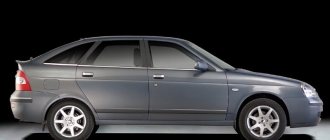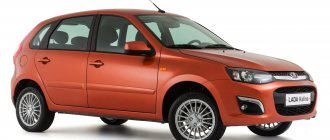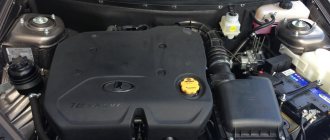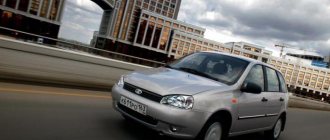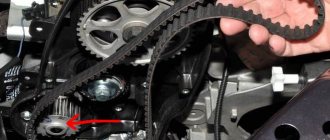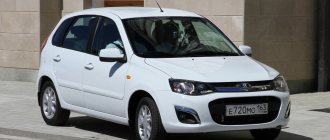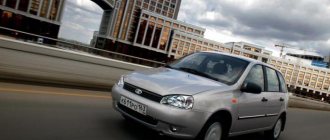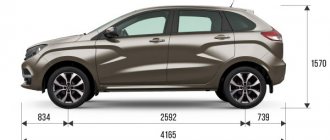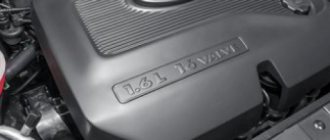Those. characteristics
Lada (VAZ) 2170 (Priora) (2007(2013)) 2013 – present gg.
| Brand and modification | Body type | Volume | Power | Release |
| Lada (VAZ) 21703 (Priora) | sedan (4 doors) | 1596 cm3 | 98 hp | 03.2013 – present |
| Lada (VAZ) 21703 (Priora) | sedan (4 doors) | 1596 cm3 | 106 hp | 03.2013 – present |
| Lada (VAZ) 21713 (Priora) | station wagon (5 doors) | 1596 cm3 | 98 hp | 2013 – present |
| Lada (VAZ) 21713 (Priora) | station wagon (5 doors) | 1596 cm3 | 106 hp | 2013 – present |
| Lada (VAZ) 21723 (Priora) | hatchback (5 doors) | 1596 cm3 | 98 hp | 2013 – present |
| Lada (VAZ) 21723 (Priora) | hatchback (5 doors) | 1596 cm3 | 106 hp | 2013 – present |
| Lada (VAZ) 21728 (Priora) | hatchback (3 doors) | 1596 cm3 | 98 hp | 2013 – present |
| Lada (VAZ) 21728 (Priora) | hatchback (3 doors) | 1596 cm3 | 106 hp | 2013 – present |
Lada (VAZ) 2170 (Priora) (2007) 2007 – 2013
| Brand and modification | Body type | Volume | Power | Release |
| Lada (VAZ) 21701 (Priora) | sedan (4 doors) | 1596 cm3 | 81 hp | 04.2007 – 2013 |
| Lada (VAZ) 21702 (Priora) | sedan (4 doors) | 1596 cm3 | 89 hp | 03.2007 – 2013 |
| Lada (VAZ) 21703 (Priora) | sedan (4 doors) | 1596 cm3 | 98 hp | 04.2007 – 2013 |
| Lada (VAZ) 21713 (Priora) | station wagon (5 doors) | 1596 cm3 | 98 hp | 05.2009 – 2013 |
| Lada (VAZ) 21721 (Priora) | hatchback (5 doors) | 1596 cm3 | 81 hp | 02.2008 – 2013 |
| Lada (VAZ) 21722 (Priora) | hatchback (5 doors) | 1596 cm3 | 89 hp | 05.2009 – 2013 |
| Lada (VAZ) 21723 (Priora) | hatchback (5 doors) | 1596 cm3 | 98 hp | 02.2008 – 2013 |
| Lada (VAZ) 21728 (Priora) | hatchback (3 doors) | 1596 cm3 | 98 hp | 01.2010 – 2013 |
View technical characteristics of other Lada (VAZ) / Lada (VAZ) models
The automobile catalog contains descriptions, technical characteristics and photographs of Lada (VAZ) 2170 (Priora) / Lada (VAZ) 2170 (Priora) cars produced since 1997.
Technical features of Lada Priora
Power unit: VAZ-21116 engine with a power of 90 hp. With. (8 valves) or VAZ-21126 with a capacity of 98 hp. With. (16 valves). The engine uses foreign-made parts. In particular, a significantly lightweight SPG of foreign production from Federal Mogul, a timing belt and a tension roller from Gates, with a declared resource of 200 thousand kilometers, were used. Installation of a 21128 gasoline engine with a working volume of 1.8 liters and a power of 120 hp. With. produced as a tuning of Togliatti. Other improvements include: a stronger clutch, a larger-diameter vacuum brake booster, and a gearbox drive mechanism with sealed bearings.
Chassis: despite the modernization of the front suspension struts with barrel springs, in general, the design of straight forged arms with diagonal reaction rods seems archaic today.
New shock absorbers are used in the rear suspension. The car has a more efficient braking system compared to the 2110, equipped with ABS and BAS (BOSCH 8.1). In addition to the front one, a rear anti-roll bar has also appeared. The rear brakes remain unchanged; According to the manufacturer, they are quite effective and do not require maintenance.
In top trim levels, the Priora can be purchased with air conditioning and climate control, heated front seats, light and rain sensors, parking sensors, electric windows on all doors, electric and heated mirrors. Lada Priora with a GLONASS/GPS navigator was shown at the Moscow Motor Show in August 2010.
Modifications of Lada Priora
Lada Priora 1.6 AMT
| Maximum speed, km/h | 183 |
| Acceleration time to 100 km/h, sec | 11.4 |
| Engine | Petrol |
| Working volume, cm3 | 1596 |
| Power, hp / rpm | 106/5800 |
| Torque, Nm/rpm | 148/4200 |
| Combi consumption, l per 100 km | 6.6 |
| Gearbox type | Robotic, 5 gears |
| Drive unit | Front |
| Show all characteristics | |
Lada Priora 1.6 MT
| Maximum speed, km/h | 176 |
| Acceleration time to 100 km/h, sec | 12.5 |
| Engine | Petrol |
| Working volume, cm3 | 1596 |
| Power, hp / rpm | 87/5100 |
| Torque, Nm/rpm | 140/3800 |
| Combi consumption, l per 100 km | 7.0 |
| Gearbox type | Mechanical, 5 gears |
| Drive unit | Front |
| Show all characteristics | |
Lada Priora 1.6 MT 106 hp
| Maximum speed, km/h | 183 |
| Acceleration time to 100 km/h, sec | 11.5 |
| Engine | Petrol |
| Working volume, cm3 | 1596 |
| Power, hp / rpm | 106/5800 |
| Torque, Nm/rpm | 148/4200 |
| Combi consumption, l per 100 km | 6.9 |
| Gearbox type | Mechanical, 5 gears |
| Drive unit | Front |
| Show all characteristics | |
Lada Priora 1.6 MT 98 hp
| Maximum speed, km/h | 183 |
| Acceleration time to 100 km/h, sec | 11.5 |
| Engine | Petrol |
| Working volume, cm3 | 1596 |
| Power, hp / rpm | 98/5600 |
| Torque, Nm/rpm | 145/4000 |
| Combi consumption, l per 100 km | 6.9 |
| Gearbox type | Mechanical, 5 gears |
| Drive unit | Front |
| Show all characteristics | |
Technical characteristics of Lada Priora sedan 1.6 liter 8v 5-speed manual transmission
| Motor power | 80 hp |
| Torque | 120 Nm |
| Acceleration to 100 km/h | 12.5 s |
| Max. speed | 172 km/h |
| Fuel type | AI-95 |
| Consumption in the city | 9.8 l |
| Highway consumption | 5.8 l |
| Mixed flow | 7.6 l |
| Volume of the tank | 43 l |
| Trunk volume | 430 l |
Types of configurations for production models of Lada Priora
The presentation of the model began to be prepared already in 2006, and a year later the first version rolled off the assembly line. The VAZ factory index is 2170. The platform for production was the base from the Lada 110.
Unlike the “10”, the doorways have become wider by 7%. Absolutely new form of optics, hood, luggage compartment lid, fenders, sills. Standard wheels "Kama Euro" 185/65 R14.
High-quality polymer materials were used in the finishing. The upper contour is made in light colors, the lower one in dark colors. The two-tone door trims look great.
On the armrests of the front doors there are pre-installed control units for double-glazed windows, adjustment of side mirrors, and a central locking remote control. The ergonomics of mechanical keys are designed to prevent accidental pressing.
Between the front seats there are two storage compartments for storing small items. On the headliner in the front part there is a lamp with lighting and a place to store sunglasses (see photo).
The information content of the dashboard is good, the indicators are arranged in a cluster, providing a generalized picture of the functionality of the technical tool.
In the central part of the tidy there is a place for a monochrome display of the electronic engine control unit (ECU). Of course, the window is small, but it is quite sufficient for visual diagnostics.
To the left of the steering column there is a control module for side lights, high and low beam. Pre-installed electric headlight adjustment and dashboard brightness control.
The mechanical button for activating the trunk lid has been moved to the central channel. The useful space of the luggage compartment is estimated at 430 liters. Unfortunately, you can open the lid using a button from the inside or on the key fob. There is no mechanical button on the lid itself.
In the center of the dashboard there is a connector for installing a DIN, 2DIN radio (with LCD display).
In the engine compartment there is a 1.6-liter power unit, 98 hp, with a torque of 145 Nm. Transmission type: five-speed manual. In order to increase the efficiency of the braking system, a vacuum booster is pre-installed.
Reinforced shock absorber struts and improved front suspension design improve driving comfort.
All production models of Lada Priora comply with Euro 4 standards. This is possible due to the displacement of the standard catalyst closer to the exhaust manifold. As a result, the catalysis process occurs much faster due to an increase in operating temperature.
Disadvantages, breakdowns and problems of Lada Priora 2170
Body
The body's resistance to corrosion is weak; rust can already be found on two-year-old cars. The paintwork is thin, chips form quickly and literally immediately turn yellow.
Salon
The interior begins to squeak from the first kilometers and over time the squeaks only intensify. There is no sound insulation here, the front seats are uncomfortable, and the back is quite cramped.
But the main headache is the electrics. Anything breaks here, anytime. Moreover, repairs do not guarantee that the same thing will not fail again the next day.
Engine
There were four 1.6-liter power units, but their main problems were generally similar:
- failure of sensors, and on new engines and electronic throttle
- breakage of the timing belt due to old age, a wedge of one of its rollers or a water pump
- sticking of the thermostat, followed by engine overheating and gasket breakdown
- oil leaks causing it to get into the spark plug wells and fogging of the ventilation breather
Transmission
The original mechanics of the VAZ 2170 are essentially a slightly strengthened version of the Lada 110 gearbox and are famous for unclear switching, release noise and weak synchronizers.
The new manual transmission VAZ 2180 with cable drive is more reliable and more pleasant to use. The VAZ 2182 robot has received mixed reviews, read about it in a separate article.
Suspension
The suspension is the car's strong point and is ideal for our roads. Reliability is quite good; the first things to be replaced here are steering ends and wheel bearings. Next, the ball joints and support bearings of the struts fail, but they are inexpensive.
The brakes are quite normal, but the original pads need to be replaced as soon as possible. The first years of production there were a lot of problems with a defective electric power steering.
Specifications
Below we will talk about each element of the Lada Priora separately, namely, we will consider separately the body, engine, trunk, etc.
Body
Priora was produced in several bodies. In 2007, only a sedan appeared; later, in 2008, the first hatchback and station wagon rolled off the assembly line.
Sedan 2170
This body turned out to be very nice and most popular among young people. Young people started buying Priora and subjecting it to various tunings. It became a kind of youth movement.
Station wagon 2171
This type of body is an excellent solution for family people. The station wagon is equipped with a huge trunk.
Hatchback 2172
The hatchback does not differ from the sedan in technical characteristics and the front part of the body, but is shorter by several centimeters, which is noticeable to the naked eye.
Engine
Several types of engines with different power and number of valves were installed on the Lada. The table below shows all installed engines and their characteristics.
| Model | 21126 | 21127 | 21116 |
| Number of valves | 16 | 16 | 8 |
| Power (hp) | 98 | 106 | 87 |
| Type | Petrol | Petrol | Petrol |
| Torque, Nm / rpm | 145/4000 | 148/4200 | 140/3800 |
| Number of cylinders | 4 | 4 | 4 |
| Cylinder arrangement | Row | Row | Row |
| Volume (cubic cm) | 1596 | 1596 | 1596 |
| Fuel | Gasoline AI 95 | Gasoline AI 95 | Gasoline AI 95 |
| Power type | Electronic injection | Electronic injection | Electronic injection |
| Maximum speed, km/h | 183 | 183 | 172 |
| Acceleration time to 100 km/h | 11,5 | 11,0 | 12,5 |
| Average fuel consumption per 100 km | 7,2 | 7,2 | 7,6 |
Gear box
Priora was equipped with several gearboxes depending on the configuration and year of manufacture of the car. All gearboxes are 5-speed
Gearbox with rocker
This gearbox was installed on cars from 2007 to 2013. It is a fairly reliable and unpretentious gearbox, its main “soreness” is the weak second gear, which begins to fly out over time.
Cable gearbox
Installed on cars since 2014. Received a large number of positive reviews, the position of the gears, namely the reverse gear, has changed. The vibrations transmitted to the cabin from the gearbox have been reduced.
Robotic gearbox
In 2014, luxury car models began to be equipped with a robotic gearbox. It is very reliable and unpretentious, but noticeably loses in dynamics compared to a manual transmission.
Other characteristics
| Characteristic | Sedan | Station wagon | Hatchback |
| Height, mm | 1420 | 1435 | 1508 |
| Width, mm | 1680 | 1680 | 1680 |
| Length, mm | 4350 | 4340 | 4210 |
| Wheelbase, mm | 2492 | 2492 | 2492 |
| Weight, kg | 1163 | 1163 | 1088 |
| Number of seats | 5 | 5 | 5 |
| Number of doors | 5 | 5 | 5 |
| Drive unit | front | front | front |
| Wheels | 185/65 R14 | 185/65 R14 | 185/65 R14 |
| Tank capacity, l | 43 | 43 | 43 |
| Trunk volume, l | 430 | 444/777 (with rear seats folded) | 360/705 (with rear seats folded) |
Life hack: VIN code on Priora, where it is located and how it is deciphered
Each car is marked with a special unique number, which is applied to the parts during their production. After the car is registered, the traffic police officer can fully check it by number and VIN code - if everything matches in the documents and the real “picture”, there will be no problems.
Such strict accounting was adopted in order to exclude illegal fraud - duplicate license plates, installation of an engine from a stolen car, etc. Therefore, the VIN code of a Lada Priora car is an element that should never be removed - rubbed, glued, or try to remove it in another way.
Over time, when car production volumes increased significantly, it was necessary to create a unified accounting system so that it would be impossible to falsify documents or assemble a car from parts of stolen cars. Traffic police and traffic police officers in other countries were able to track all vehicles, monitor the payment of fines and registration actions, which greatly simplified their work.
1 - code on the counter, 2 - plate
How much does Lada Priora weigh?
The weight of the car before restyling in 2013 was as follows:
- The 3-door hatchback coupe, 5-door hatchback and sedan have a curb weight (which includes the weight of a full tank of fuel and the driver) of 1088 kg. In this case, the total weight (i.e., the maximum permissible weight of the vehicle at which it can be operated after being fully loaded) is 1578 kg;
- The station wagon, with the same curb weight, is able to take a little more cargo, and its total weight reaches 1593 kg.
Thus, the station wagon is the most load-carrying of all Priora body types.
Cargo capacity
Cargo capacity (not payload!) of the Prior varies depending on the body type. So, trunks have different volumes:
- 360 liters – for hatchback and coupe;
- 430 liters - for the sedan;
- 444 liters - for the station wagon.
As we can see, this volume is not very different from the sedan’s, so it’s a very stretch to say that the Priora station wagon was created to solve a wide range of economic problems (relative to other variants of this car). Of course, cargo capacity increases significantly if you fold the back of the rear sofa, or even better, remove the entire rear seat.
History of the creation of Lada Priora
Lada Priora is an updated version of the popular model of the VAZ 2110 family, discontinued in 2007.
Due to the fact that about a thousand changes were made to the design of the “ten” to transform it into the Lada Priora, the VAZ-2170, 2171, 2172 and other modifications can be considered a new family. The Priora family includes three models: VAZ-2170 - sedan, produced since March 2007; VAZ-2172 - hatchback, since February 2008; VAZ-2171 is a station wagon, produced since May 2009. As a result of a significant modernization of the 2110 family, AvtoVAZ received a new, comfortable car that meets the basic standards of the modern market. Even in the basic configuration, the car has a significant set of options: an airbag, electric front door windows, electric power steering, central locking with remote control, height-adjustable seat belt mounts and steering column, electronic clock, athermal glass.
Since Priora is officially considered a restyling product, you can see a “ten” in the middle part of the body, but the bow and stern have nothing in common with similar parts of the previous model.
The exterior was entirely designed by Volzhsky designers from the Italian studio Carcerano. Thanks to their help, the front panel can no longer be classified as “Russian”, since it rather resembles the average dashboard of a foreign-made car. The panel is trimmed with soft plastic, the visor above the instrument cluster has a curved shape that goes well with the oval-shaped clock built into the silver trim at the top of the console.
In addition to the Italians, specialists from Italy, Germany, France, Japan and Korea took part in the creation of the machine.
In March 2007, the first small batch of Priora sedans was released. A month later, in April 2007, cars began to arrive in showrooms. In 2010, a small restyling was carried out.
In 2022, according to the press service of the Volzhsky Automobile Plant, it is planned to release a new generation Priora, on the new Lada B platform. AvtoVAZ previously announced that the 2017 Priora will outwardly resemble the Lada Xray concept car, the author of which was Steve Mattin, the new chief designer of the plant.
Dimensions of VAZ 2170 and other modifications of Priora
The dimensions of the car are something that needs to be taken into account when purchasing, since the dimensions of parking spaces, garages, turns or entrance arches are not always universal. The height is measured from the extreme point of the front to the extreme point of the rear bumper. The width is measured at the widest point, and the height is measured from the surface of the ground to the highest point of the roof. Roof rails and racks do not fit into the height of the body. Taking this into account, the dimensions of the Priora are as follows:
- The longest body of cars in this family is the sedan. It measures 4350 mm in length. But at the same time it is the lowest - 1420 mm. in height.
- The next longest is the station wagon, with its 4340 mm length. It is the highest in height – 1508 mm.
- The five-door hatchback and three-door coupe are the shortest - 4210 mm. at 1435 mm. in height.
In all four cases, the width of the Priora is the same - 1680 mm. Ground clearance is 165 mm, although in the Priora Sport configuration it is somewhat reduced, but this is no longer so important, since this car is no longer produced in this version.


